Louis R. Bevier
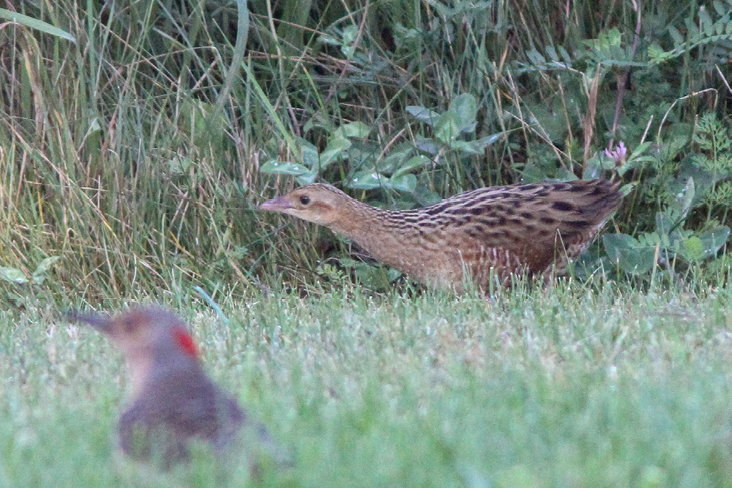
Corn Crake, a first for Maine since 1889, was on Monhegan Island October 5, 2014. Photograph by Doug Hitchcox.
This 7th report of the Maine Bird Records Committee (hereafter ME-BRC or the committee) summarizes the assessment of 37 reports involving 23 species. Evaluation of and decisions by the committee for these reports occurred during 2017. The committee accepted 32 records for an acceptance rate of 86%. Although the majority of birds in this report were documented in 2016–2017, the years of occurrences range from 1953 to 2017.
Highlights in this report include four species accepted as documented for the first time in the state of Maine: Snowy Plover, Gray-tailed Tattler, Vermilion Flycatcher, and Fieldfare. In addition, the first state records for Garganey and Wilson's Plover, previously unreviewed but accepted provisionally, are accepted here. An older record of Vermilion Flycatcher that had been relegated to the hypothetical list is here accepted as the first for the state along with a recent record. These bring the total number of accepted species on Maine's state list to 456. The official list of bird species recorded in Maine, our review procedures, and members can be found at the committee's website.http://sites.google.com/site/mainebirdrecordscommittee.
Records in this report are grouped by species, with both those accepted and those not accepted listed within the same species account. Each account provides the location, county (italicized), date(s) of occurrence, names of observers or contributors, and committee record number. Observers listed are those providing documentation to the committee, or in some cases, documentation harvested from publicly published Web sites. All reviewed materials and member comments are archived. If known, the names of finders are listed first and separated from other names by a semicolon. Photographic, video, or audio evidence reviewed is denoted by a dagger (†); written notes are denoted by an asterisk (*). As always, the committee strongly encourages written submissions even when there are photographs. Species accounts follow the current taxonomic classification and sequence adopted as of 2017 by the American Ornithological Society (list available at http://checklist.aou.org/taxa/).
Species Accounts
Barnacle Goose (Branta leucopsis). A pair spent ten days at Collins Pond, Caribou, Aroostook, October 11–20, 2016, and later at Lake Josephine, Easton, Aroostook, October 26, 2016 (Bill Sheehan†; Josh Fecteau†, Bruce Barker, Bruce Cole†, Bob Crowley†, Bob Duchesne†, Steve Mierzykowski†, Robert O'Connell†, Marian Zimmerman*; 2016-029). A report from October 29, also at Lake Josephine, was not accepted by the committee.
Garganey (Spatula querquedula). A male associating with Blue-winged Teal (S. discors) was present near Messalonskee Lake, Belgrade, Kennebec, June 20, 1994, (David Ladd* et al.; 1994-002). This is the first record for Maine (Despres and Brinker 1994). Ladd's original notes had not previously been reviewed, and attempts to recover notes by other observers cited as present (Arthur Stackhouse, Julie Suchecki, D. Winslow) were unsuccessful. The late June timing is perhaps later than expected for a vagrant, but there are other June records for Quebec, the Maritimes, and the Northeastern United States. The ornamental scapular plumes were not noted on this individual. They were either overlooked or not fully grown. The "elongated scapulars or tertials [are] sometimes not fully grown upon arrival in breeding areas" (Cramp et al. 1977). An April 1999 record of a male photographed at Weskeag Marsh, South Thomaston, Knox, remains unreviewed.
Chuck-will's-widow (Antrostomus carolinensis). One was heard and audio recorded at Ellsworth, Hancock, May 24–[about] June 7, 2016 (Stephanie Monk†; 2016-027). NOT ACCEPTED, IDENTIFICATION QUESTIONED: nebulous reports from Jefferson, Lincoln, mid-May to May 28, 2012, (unknown observer fide Kristen Lindquist; 2012-023) and Swans Island, Hancock, May 28–29, 2012, (unknown observer fide Bill Townsend; 2012-024) had no details on which to determine identification. A bird flushed and seen at a distance in Friendship, Knox, May 21, 2016, (2016-008) was thought by a majority of the committee as probably correct, but the brevity of the sighting along with minor details did not eliminate the possibility of error.
Corn Crake (Crex crex). An immature was photographed on Monhegan Island, Lincoln, October 5, 2014 (Doug Hitchcox†; 2014-016). This is the second record for Maine and comes 126 years after the previous record, a specimen taken October 14, 1889, at Falmouth (unreviewed but specimen verified as this species; another bird was taken at the same time but not preserved; Palmer 1949). The Monhegan bird was initially identified as an immature Sora (Porzana carolina) until corrected by Luke Seitz during review of photographs submitted to eBird. Formerly a casual vagrant to northeastern North America in the 1800s and early 1900s, vagrancy of this long-distance migrant diminished with declines of Corn Crake populations in western Europe. A significant increase in vagrants has occurred recently, however, with seven records in the New World from 2002 to 2017—Newfoundland, Guadeloupe, Bermuda, Brazil (first for South America; de Burgos and Olmos 2013), Maine, Pennsylvania, and New York.
Black-necked Stilt (Himantopus mexicanus). A first-year female with worn, retained juvenile outer primaries and outer secondaries as well as outer rectrices was at Weskeag Marsh, South Thomaston, Knox, August 2–12, 2017 (Dennis McKenna; Keith Carver†, Don Reimer†, and many observers submitting to eBird; 2017-025).
Snowy Plover (Charadrius nivosus). A male was present at Reid State Park, Georgetown, Sagadahoc, June 13, 2017 (Zac Fait†; Mimi Edmunson*, Lysle Brinker†, Josh Fecteau†, Noah Gibb†; 2017-016). This is a first for Maine and one of only a few for New England. Interestingly, two months prior to the Maine bird, a Snowy Plover, possibly the same male, was photographed at Goosewing Beach Preserve, Newport, Rhode Island, April 17, 2017 (Geoff Dennis, eBird). The other New England records are one in Massachusetts (summer 1994) and a bird in Connecticut (fall 2004) that is perhaps best regarded as Kentish/Snowy Plover (C. alexandrinus/nivosus).
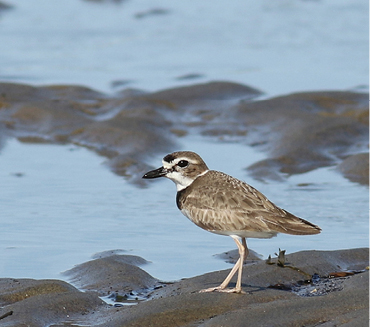
Wilson's Plover was at Popham Beach, Maine, June 22–24 (here), 2016. Photograph by Brendan McKay.
Wilson's Plover (Charadrius wilsonia). One at Wells Beach, Wells, York, August 25, 1953 (Irma A. Werner; 1953-001) is the first for Maine (Werner 1953). The committee was initially split but ultimately agreed that the description supported the identification. Among concerns, late August was thought unusual for a species that typically occurs as a vagrant to New England from late spring into early summer. During the 1950s, however, this species bred as far north as New Jersey and was a somewhat more regular visitor to southern New England (Zeranski and Baptist 1990); vagrants in recent decades have lingered in Massachusetts until early September. One at Popham Beach, Phippsburg, Sagadahoc June 22–24 and July 11, 2016 (Laura Zitske; Doug Hitchcox†, Josh Fecteau†, Helmut Heuer*, Brendan McKay†; 2016-014). NOT ACCEPTED, IDENTIFICATION QUESTIONED: A published report at Addison, Washington, September 2, 1993, (Wilhelm 1993, 1994; 1993-001) failed to gain acceptance. A fall occurrence during the 1990s met greater scrutiny. The description is somewhat flawed and did not eliminate a possible sand-plover (C. mongolus/leschenaultii). Moreover, the observer reported an extraordinary and unlikely ratio of peeps (Calidris sandpipers), suggesting potential for error. Historical tracks for Hurricane Emily of 1993, cited as a possible transport mechanism, reveal that storm to have been highly unlikely as a source for a Wilson's Plover in New England.
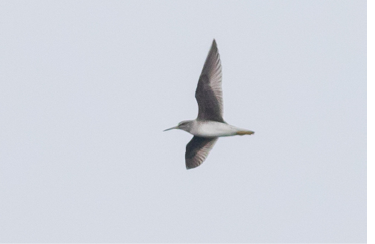
Gray-tailed Tattler, Maine's first and New England's second, flew over Matinicus Rock August 14, 2017. Photograph by Earl Johnson.
Gray-tailed Tattler (Tringa brevipes). One was photographed at Matinicus Rock, Knox, August 14, 2017 (Earl Johnson; 2017-028). Johnson heard a two-note golden-plover-like call and wisely took photos of the flying bird. The call notes, a mellow tuu-eet, along with the images allow identification as Maine's first and New England's second Gray-tailed Tattler. Characters shown in the photos that support the identification include: mostly white sides and flanks with apparent fine barring; Wandering Tattler (T. incana) would be either broadly gray on its sides and flanks or extensively barred below); a whitish supercilium extending behind the eye (supercilium stops at the eye in Wandering Tattler); and upperparts that appear tinged brown and contrast with paler rump and dorsal tail (grayer and uniform without contrast on Wandering Tattler).
Long-tailed Jaeger (Stercorarius longicaudus). At least two, and possibly three, first-summer birds were off Bar Harbor, Hancock, July 21, 2017 (Kyle Lima†; 2017-024). The committee agreed that at least two were Long-tailed Jaegers, but failed to reach agreement on all three. Separate juveniles were photographed at Seal Island, Knox, July 21, 2017 (Keenan Yakola†, Will Kennerley, Earl Johnson, and John Drury; 2017-027) and July 28–August 5, 2017 (Keenan Yakola†; 2017-039). Two first-summer birds were at Seal Island, Knox, August 10–13, 2017 (Keenan Yakola†, Isabel Brofsky; 2017-041).
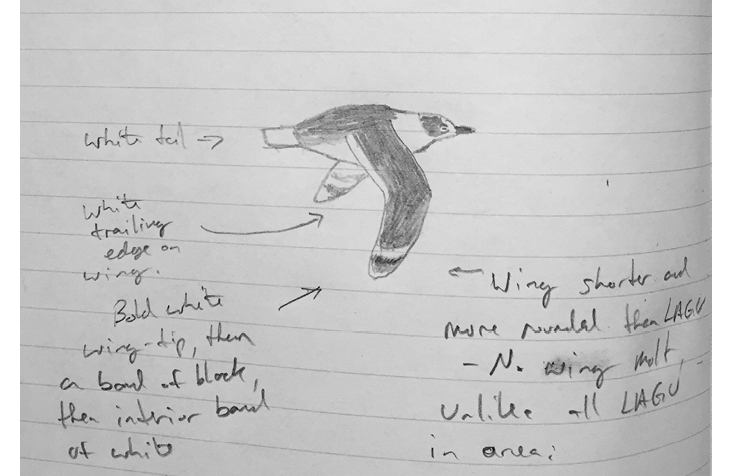
This Franklin's Gull was well-described and expertly sketched when seen off Rockland, Maine, August 24, 2016. Notes and sketch by Christian Nunes.
Franklin's Gull (Leucophaeus pipixcan). An adult in basic plumage was well described by an experienced observer off Rockland Harbor, Knox, August 24, 2016 (Christian Nunes*; 2016-024).
Bridled Tern (Onychoprion anaethetus). An adult in breeding plumage visited the tern colony at Machias Seal Island, Washington, July 6, 2017 (Ralph Eldridge† and Mark Dodds; Collette Lauzau*; 2017-020). Photos show white on the underwing extending as rays distally along the inner webs of outer primaries, a white supercilium extending posterior to the eye, and gray-brown upperparts. Sooty Tern (O. fuscatus) shows a sharp break from the white underwing coverts to the black underside of the primaries, a supercilium that stops at the eye, and blacker upperparts. This or another Bridled Tern spent about two weeks at a tern colony on Falkner Island, New Haven, Connecticut, arriving there twelve days after the Machias Seal Island sighting.
Pacific Loon (Gavia pacifica). Three records were accepted: off Biddeford Pool, York, November 18–25, 2015 (Andrew Aldrich† and Alan Murray; Kevin Couture†; 2015-013); off Biddeford Pool, York, December 2–4, 2016 (Derek Lovitch†; Josh Fecteau†, Pat Moynahan* 2016-033); off Cliff House, Cape Neddick, York, and later off Ogunquit, York, January 28–February 19, 2017 (Dennis McKenna*; Edward Flanders*, Derek Lovitch†, and Jeannette Lovitch; 2017-006).
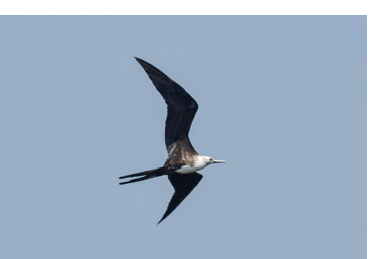
Magnificent Frigatebird, a juvenile, was at Stratton Island June 12, 2017. Photograph by Zeke Smith.
Magnificent Frigatebird (Fregata magnificens). A juvenile was at Stratton Island, Saco, York, June 12, 2017 (Wray Gabel and Zeke Smith†; Josh Fecteau†, Timothy Fennell†; 2017-014). The brown triangular wedge extending medially at the breast sides combined with all-white head, gray bill, and triangular, white rear belly patch combined to eliminate Great Frigatebird (F. minor). NOT ACCEPTED, IDENTIFICATION QUESTIONED/LOCATION-DATE UNCERTAIN: A secondhand report attributed to Kittery, York, October 1 or 3, 2016, (2016-028) was not certainly a frigatebird nor certainly seen in Maine.
Brown Booby (Sula leucogaster). An adult female, based on a dusky spot anterior to the eye and yellow skin around the base of the bill, was photographed offshore over the Schoodic Ridges, Hancock, September 17, 2017 (Phillip Torrey†; 2017-033). (See photograph on page 189).
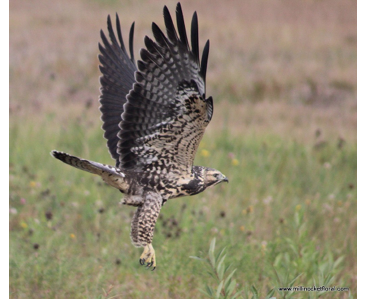
Swainson's Hawk is a rare visitor to Maine, and this juvenile was at Millinocket September 26–October 4, 2016. Photograph by Rhonda Little.
Swainson's Hawk (Buteo swainsoni). A juvenile visited the Millinocket Municipal Airport, Penobscot, September 26–October 4, 2016 (Anita Mueller† and Rhonda Little-Aifd†; many observers and photographs; 2016-026).
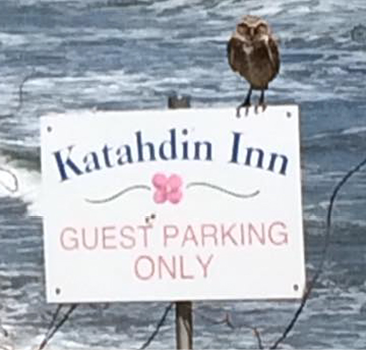
Burrowing Owl has been seen only once before in Maine. This one was at York June 7, 2017. Photograph by Jon Colcord.
Burrowing Owl (Athene cunicularia). One was along Short Sands beach, York, York, June 7, 2017 (Courtney Smith; Jon Colcord†; 2017-015). The pattern on the underparts showing a white central divide to the breast band and then much diminished broken bars on the abdomen is consistent with western populations, A. c. hypugaea. Currie and McLaren (2012) discuss identification of Burrowing Owl subspecies and their occurrence in northeastern North America.
Say's Phoebe (Sayornis saya). Two records: one at Pemaquid Point, New Harbor, Lincoln, September 6–9, 2016 (Joe and Wendy Mallory†; Louis Bevier†, Josh Fecteau†, Doug Hitchcox†; 2016-025), and another on Monhegan Island, Lincoln, September 16–17, 2017 (Jess Foley*; Kristen Lindquist†; 2017-031).
Vermilion Flycatcher (Pyrocephalus rubinus). A well-described male was on Isle au Haut, Knox, May 9, 1994 (Debra Schrader*and Dave Hiltz, Jr.*; 1994-003). Another male, apparently a first-year, visited Hog Island, Lincoln, April 17, 2017 (Arlene Beech, Olivia Brohammer†; Louis Bevier†, Josh Fecteau†, Nathan Hall†, Doug Hitchcox†; 2017-007). The Isle au Haut bird was previously published (Perkins 1994, Schrader and Hiltz, Jr. 1994) but long regarded as hypothetical, chiefly due to it being a sight report from a time of year outside the pattern of vagrancy for the species to the Northeast. The Hog Island bird provided fresh impetus to review the older report. This record was a remarkable find for other reasons too. It was first observed by a volunteer in the United Kingdom monitoring an Osprey nest camera hosted by National Audubon and Explore.org. News was shared, and a short video clip provided a close-up view of the bird (https://www.youtube.com/watch?v=IcTGkbcmp9M). Given that most vagrants of Vermilion Flycatcher to eastern North America are immatures in fall, members discussed the potential that these spring records could involve austral migrants from populations that breed in southern South America (rubinus subspecies group) and would be in migration to northern South America during the boreal spring, a pattern shared with Fork-tailed Flycatcher (see below). These austral migrant Vermilion Flycatchers are regarded by some authors as a separate species, Scarlet Flycatcher (Carmi et al. 2016, Gill and Donsker 2018). North American Vermilion Flycatchers (mexicanus subspecies group) are only separable from Scarlet Flycatchers in the field by vocalizations. Besides the Maine birds, the only other spring record in the Northeast is a male photographed at Burton Island, Delaware, May 2–5, 1993 (Hess et al. 2000).
Fork-tailed Flycatcher (Tyrannus savana). One adult male at Gilsland Farm, Falmouth, Cumberland, September 16–19, 2017 (Angus King†; Barbara Carlson†, Doug Gochfeld†, many observers; 2017-044). Photos show three deeply emarginated outer primaries consistent with the austral migrant, nominate T. s. savana (Zimmer 1937).
Fieldfare (Turdus pilaris). Maine's first accepted record for this Eurasian thrush was at Newcastle, Lincoln, April 19–23, 2017 (Jeff Cherry†; many observers and photographs; 2017-008).
Lesser Goldfinch (Spinus psaltria). An adult male black-backed form visited a feeder at Whetstone Pond, Abbot, Piscataquis, August 3–5, 2015 (Ellen Blanchard; Cheryl Ring†, Louis Bevier†, Doug Hitchcox†, Margaret Viens†; 2015-015).
Harris's Sparrow (Zonotrichia querula). An immature visited a feeder at Belgrade, Kennebec, November 17, 2016 (Seabird McKeon†; 2016-031).
Bullock's Oriole (Icterus bullockii). A long-staying immature male was at Camden, Knox, November 14, 2016–April 2, 2017 (Melinda Sortwell†; many observers and photographs; 2016-032); another immature male was seen at Alexander, Washington, December 1–8, 2016 (Grazyna Kirsch†; 2016-034).
Dedication
The committee lost one of its founding members in 2017. Peter Vickery passed away on February 28, 2017 (see in memoriam by Jan Pierson, a past committee member, and Malcolm Hunter, Jr. https://doi.org/10.1642/AUK-17-121.1). Peter's numerous contributions and expertise will be missed. His legacy will be a comprehensive volume on the status and distribution of Maine's birds, the topic that motivated Peter to establish the committee.
Acknowledgments
The committee thanks Peter Vickery for help digging up old notes. Thank you to the following for help: Regina Hornung, coordinator of Osprey cameras, and Juanita Roushdy, both of whom alerted Maine birders about the Vermilion Flycatcher; Jason Forbes, Chris Hepburn, and Sylvia Martin from the Brookline Bird Club; Greg Hanisek and Julian Hough regarding Connecticut records; and Steve Howell on frigatebird identification. Thank you to the following committee members and secretary who provided comments on drafts of this report: Tom Aversa, Doug Hitchcox, Becky Marvil, Trevor Persons, and Bill Sheehan. The committee as of June 2018 includes: Tom Aversa, Louis Bevier (chair), Lysle Brinker, Doug Hitchcox, Becky Marvil (secretary), Pat Moynahan, Will Russell, Luke Seitz, Bill Sheehan, and Margaret Viens. Trevor Persons, past chair of the committee, voted on many of the records in this report; Trevor rotated off the committee in fall 2017.
References
- de Burgos, K., and F. Olmos. 2013. First record of Corncrake Crex crex (Rallidae) for South America. Revista Brasileira de Ornitologia 21(3): 205–208.
- Carmi, O., C. C. Witt, A. Jaramillo, and J. P. Dumbacher. 2016. Phylogeography of the Vermilion Flycatcher species complex: Multiple speciation events, shifts in migratory behavior, and an apparent extinction of a Galápagos-endemic bird species. Molecular Phylogenetics and Evolution 102: 152–173.
- Cramp, S., and K. E. L. Simmons, (editors). 1977. Handbook of the Birds of Europe, the Middle East, and North Africa: The Birds of the Western Palearctic. Vol. 1: Ostrich to Ducks. Oxford, United Kingdom: Oxford University Press.
- Currie, D. A., and I. A. McLaren. 2012. Nova Scotia's First Burrowing Owl. Nova Scotia Birds 55(1): 44-48.
- Despres, J., and L. Brinker. 1994. The Nesting Season: 1 June–31 July, 1994. Maine Bird Notes 7(2): 40–44.
- Gill, F., and D. Donsker (editors). 2018. IOC World Bird List (v8.1). doi: 10.14344/IOC.ML.8.1.
- Hess, G. K., R. L. West, M. V. Barnhill, III, and L. M. Fleming. 2000. Birds of Delaware. Pittsburgh, Pennsylvania: University of Pittsburgh Press.
- Palmer, R.S. 1949. Maine Birds. Bulletin of the Museum of Comparative Zoology 102.
- Perkins, S. 1994. New England Region. National Audubon Society Field Notes 48(3): 274–279.
- Schrader, D., and D. Hiltz, Jr. 1994. Vermilion Flycatcher: First Maine report. Maine Bird Notes 7(2): 32-33.
- Werner, I. A. 1953. Miscellaneous bird notes. Bulletin of the Maine Audubon Society 9(4): 86.
- Wilhelm, G. 1993. Wilson's Plover. Maine Bird Notes 7(1): 5.
- Wilhelm, G. 1994. Occurrence of Wilson's Plover in Maine. Maine Naturalist 2(2): 113–114.
- Zeranski, J. D., and T. R. Baptist. 1990. Connecticut Birds. Lebanon, New Hampshire: University Press of New England.
- Zimmer, J. T. 1937. Studies of Peruvian birds. No. XXVII: Notes on the genera Muscivora, Tyrannus, Empidonomus, and Sirystes, with further notes on Knipolegus. American Museum Novitates 962: 1–28.
Louis Bevier can be reached at 25 Great Meadow Lane, Fairfield, Maine 04937, email: lrbevier@colby.edu.